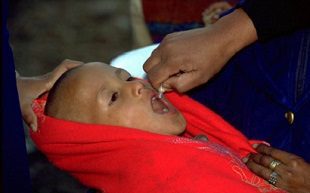Eradication of poliomyelitis appears to be on track: types 2 and 3 polioviruses have been declared eradicated, and in the past 12 months there have been just 338 cases of type 1 polio in Afghanistan and Pakistan. But there have also been 491 cases of polio caused by the type 2 Sabin vaccine. The development of a modified version of the type 2 vaccine component could improve this situation.
The oral poliovirus vaccines (OPV) developed by Albert Sabin have played a huge role in reducing cases of polio globally from 400,000 a year in 1980 to the current numbers. Their success, however, comes with a cost: they may in rare cases cause the disease they are designed to prevent. The three serotypes of OPV are taken orally and then reproduce in the intestines where they confer effective immunity to polio. During reproduction of the viruses in the intestine, the mutations originally selected by Sabin to eliminate the neurovirulence of the viruses are lost. Most immunized children shed vaccine revertants, and about 1 in 1.4 million vaccine recipients contract polio.
These vaccine revertants also circulate extensively throughout the human population, and may cause outbreaks of polio in areas where vaccine coverage drops. To address this problem, in 2016 WHO removed the type 2 component of poliovirus from OPV, which is responsible for most of the vaccine-associated cases. However vaccine-derived type 2 polioviruses continue to circulate even after this vaccine withdrawal and have caused a number of outbreaks. The response to control these outbreaks is to conduct mass immunizations with OPV type 2 – which re-introduces vaccine-derived polioviruses into the environment.
The solution might be to develop a more genetically stable strain of type 2 OPV. Such strains have been developed by leveraging advances in basic research on polioviruses that have been carried out since the 1980s. A new OPV2 strain (nOPV2) was developed by introducing three different types of changes in the OPV2 genome. First, mutations were introduced in the 5′-noncoding region of the viral RNA in the area of a single base that is a major attenuating mutation in OPV. These changes were designed to stabilize this region against reversion. Second, an RNA stem loop structure called the cre element, which is essential for viral RNA synthesis, was relocated from its original position in the genome to the 5′-noncoding region. This alteration should prevent RNA recombination that would replace the viral 5′-end with that of other enteroviruses, thereby removing the stabilizing changes. Finally, the RNA polymerase was modified so that it made fewer copying errors and had reduced recombination frequency.
The resulting nOPV2 was tested extensively in cells in culture and in experimental animals to demonstrate that the virus did not revert within the 5′-noncoding region, did not recombine with other enteroviruses, and maintained an attenuation phenotype in animals.
Based on these findings nOPV2 and another redesigned strain produced by codon-deoptimization were tested in a phase I trial. The adult volunteers, previously immunized with poliovirus vaccine, were housed in a containment facility to prevent environmental release of nOPV2. After oral administration of either vaccine, adults were monitored for symptoms, induction of immunity, and reversion of the virus to neurovirulence. The results indicated that the nOPV2s are safe, immunogenic, and do not revert to neurovirulence, while maintaining a stable 5′-noncoding region.
Pending ongoing phase 2 trials, nOPV2 is likely to be licensed for use in quelling outbreaks of type 2 vaccine-derived polio. It cannot be tested for efficacy because there are insufficient cases of polio anywhere to allow such a study. It is hoped that the excreted vaccines will not revert to neurovirulence and will circulate for a limited time in humans, as suggested by the preclinical data, thereby eliminating type 2 vaccine-induced polio. However, the numbers of subjects in the clinical trial have been small, and the selection pressure imposed by thousands of human guts might change this outcome. Viruses have been known before to defy our expectations.


Vince,
You have long been considered the ne plus ultra voice on poliovirus and polio vaccines. Would a Moderna-type multisubunit RNA vaccine expressing separately all the proteins of all the poliovirus strains have a chance of success?
No need for an RNA vaccine. Why not use the Salk (inactivated) vaccine in response to small outbreaks, as used in many western countries. OK, not so convenient as the Sabin (which I received before reversion was recognized, in the 1970s).
Pingback: A genetically stable attenuated poliovirus vaccine - Virology Hub